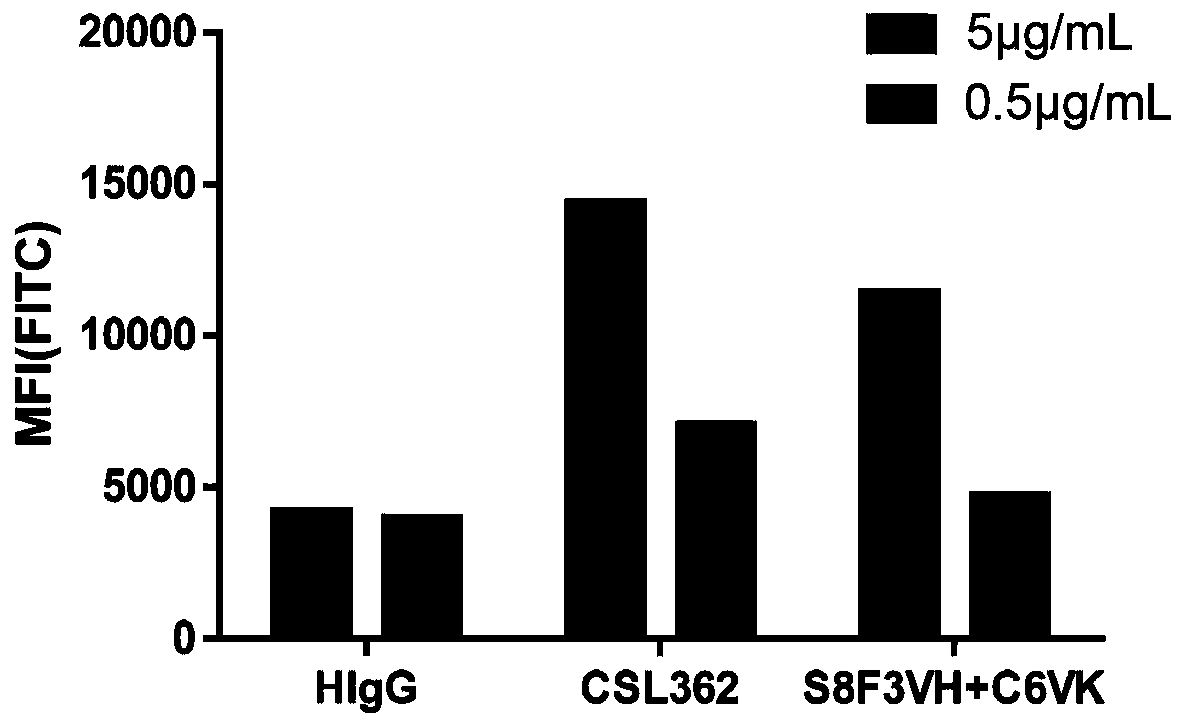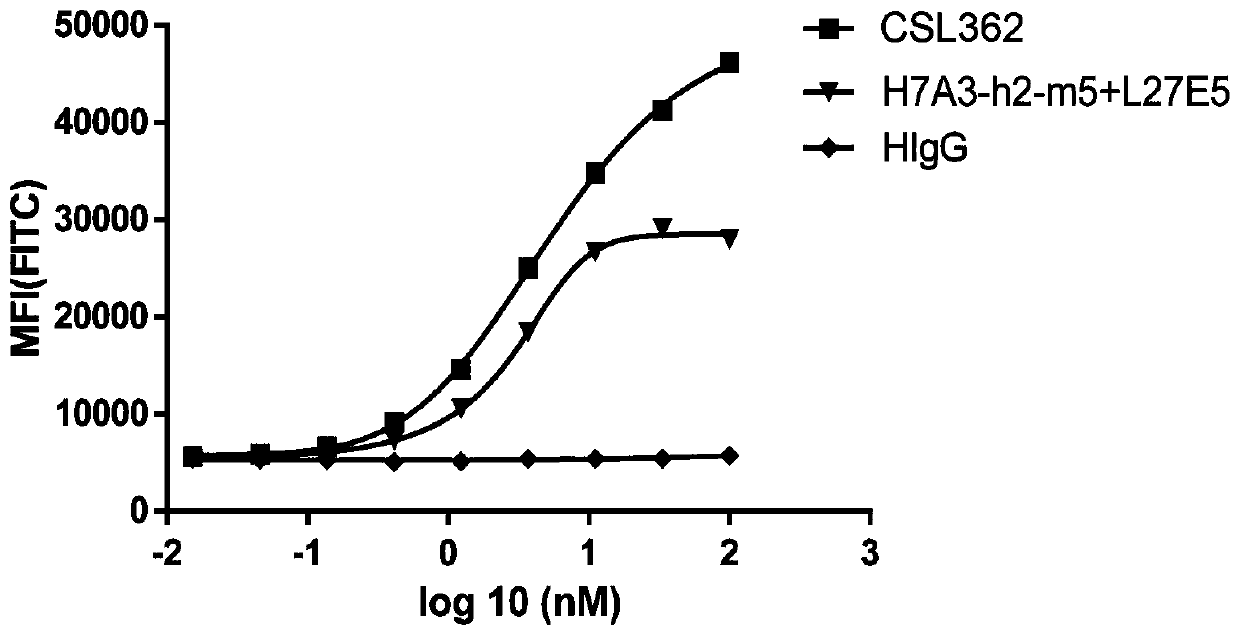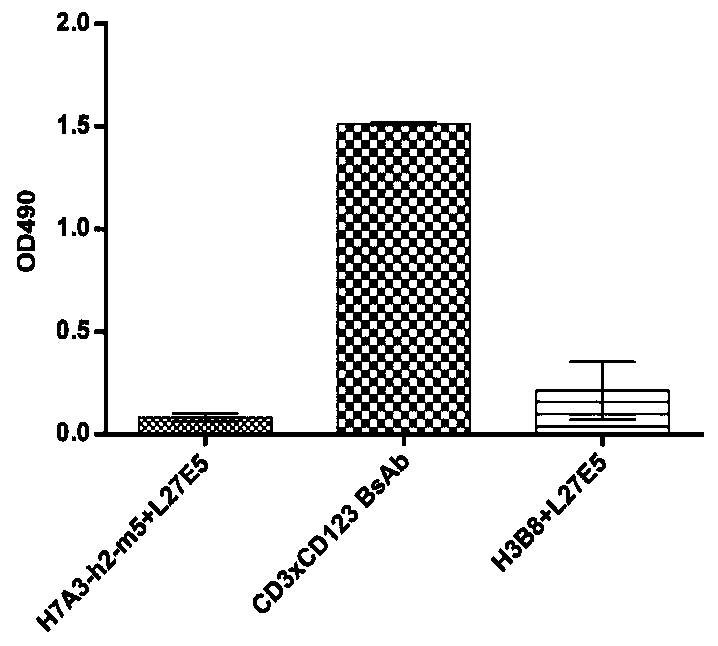Bispecific antibody resistant to CD3 and CD123 and application of bispecific antibody
A bispecific antibody, LCDR2 technology, applied in the direction of antibodies, specific peptides, anti-tumor drugs, etc., can solve the problems of inconvenient clinical application and short half-life
- Summary
- Abstract
- Description
- Claims
- Application Information
AI Technical Summary
Problems solved by technology
Method used
Image
Examples
Embodiment 1
[0190] The preparation of embodiment 1 recombinant protein
[0191] The process of preparing and identifying CD3E×CD123 bispecific antibodies requires the use of a variety of different recombinant proteins, including human CD3E extracellular region (hCD3E, SEQ ID NO: 14), human CD3D extracellular region (hCD3D, SEQ ID NO : 15), monkey CD3E extracellular region (mfCD3E, SEQ ID NO: 16), monkey CD3D extracellular region (mfCD3D, SEQ ID NO: 17), mouse CD3E extracellular region (mCD3E, SEQ ID NO: 18), Mouse CD3D extracellular region (mCD3D, SEQ ID NO: 19) and human CD123 subtype 1 extracellular region (hCD123-SP1, SEQ ID NO: 20), monkey CD123 subtype 1 extracellular region (mfCD123-SP1, SEQ ID NO: 20) ID NO: 21), mouse CD123 subtype 1 extracellular region (mCD123-SP1, SEQ ID NO: 22). These recombinant proteins have a large number of post-translational modifications (such as glycosylation or disulfide bonds, etc.), so the use of mammalian cell expression systems will be more conduciv...
Embodiment 2
[0194] Example 2 Construction of CD123 mouse immune library based on immobilized light chain
[0195] In order to construct a CD3E×CD123 bispecific antibody based on the common light chain, the light chain variable region of a specific anti-CD3E monoclonal antibody was selected to cooperate with the mouse heavy chain variable region that had undergone in vivo affinity maturation for the CD123 antigen, and conventional molecular biology methods were used to A single-chain antibody (scFv) library was constructed for screening specific antibodies against CD123.
[0196] Splenocytes were collected after cross-immunization of 6-8 week-old BALB / c mice with hCD123-SP1-His and mfCD123-SP1-His recombinant proteins. Mouse spleen lymphocytes were isolated using mouse lymphocyte separation medium (Dakowei Biotechnology Co., Ltd., CAT#DKW33-R0100), and the total RNA extraction kit (Tiangen Biochemical Technology (Beijing) Co., Ltd., CAT#DP430), the isolated lymphocytes were subjected to e...
Embodiment 3
[0197] Example 3 Screening of CD123 mouse immune library with fixed light chain
[0198] 3.1 Screening of anti-human CD123 mouse single chain antibody
[0199] Using the recombinant hCD123-SP1-his prepared in Example 1 as an antigen, a solid-phase screening strategy (experimental scheme refers to Phage Display: General Experimental Guidelines / (US) Clarkson (Clackson, T.), (US) Loman (Lowman , H.B.) edited; Ma Lan et al. Translated. Chemical Industry Press, 2008.5) screened the phage library displaying mouse single-chain antibody constructed in Example 2, and carried out by binding, elution, neutralization, infection, and amplification. After three rounds of screening, a single-chain antibody S8F3 (SEQ ID NO: 36) specifically binding to human CD123 was finally obtained.
[0200] Using conventional molecular biology methods, the nucleotide sequences encoding the heavy chain variable region S8F3VH (SEQ ID NO: 37) and the light chain variable region WM03-C6VK (SEQ ID NO: 35) of S...
PUM
| Property | Measurement | Unit |
|---|---|---|
| molecular weight | aaaaa | aaaaa |
Abstract
Description
Claims
Application Information
 Login to View More
Login to View More - R&D
- Intellectual Property
- Life Sciences
- Materials
- Tech Scout
- Unparalleled Data Quality
- Higher Quality Content
- 60% Fewer Hallucinations
Browse by: Latest US Patents, China's latest patents, Technical Efficacy Thesaurus, Application Domain, Technology Topic, Popular Technical Reports.
© 2025 PatSnap. All rights reserved.Legal|Privacy policy|Modern Slavery Act Transparency Statement|Sitemap|About US| Contact US: help@patsnap.com



